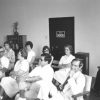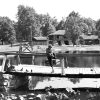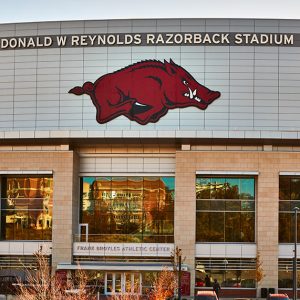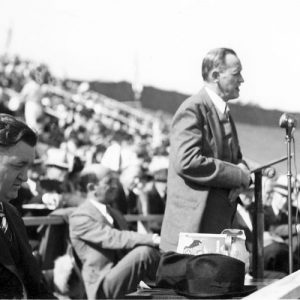calsfoundation@cals.org
Razorback Stadium
Located on the campus of the University of Arkansas (UA) in Fayetteville (Washington County), Donald W. Reynolds Razorback Stadium is the home field of the University of Arkansas Razorbacks football team. It is considered a state-of-the-art facility with such amenities as club-level seating, loge boxes, and upgraded technology. By the early twenty-first century, the stadium’s seating capacity was just over 76,000.
Originally, the Razorback football team played in a stadium that was built in 1901 on a central portion of campus known as “The Hill.” That area later became home to the Mullins Library and the Fine Arts Center. The original stadium seated three hundred.
On September 24, 1938, with federal funding from the Works Progress Administration (WPA) under President Franklin Roosevelt’s New Deal, a new stadium opened at 350 North Razorback Road, in time for the 1938 football season. It cost approximately $492,000 (about $11 million in 2025 dollars), but with federal funding under the New Deal, the University of Arkansas paid about a quarter of the price. It offered seating for 13,500. The home opener saw the Razorbacks defeat Oklahoma A&M, today’s Oklahoma State University (OSU).
On October 8, 1938, with WPA administrator Harry Hopkins in attendance, the stadium was dedicated to Arkansas’s governor, Carl Bailey, with the name officially changed to Bailey Stadium. After Bailey was defeated in the 1940 gubernatorial election by Homer Adkins, the name reverted to Razorback Stadium in 1941.
Over the years, improvements were made to the existing facility. In 1950, a new press box was constructed, and about 5,200 more seats were built on the west side. Seven years later, an equal number of seats were added to the east side. An elevated ramp was also added to make the upper tier accessible from street level. In 1958, improvements were made to the dressing rooms, scoreboard, and south entrance.
Additional construction projects came in 1965 and 1969, increasing the seating capacity to 42,678. The synthetic playing surface AstroTurf was installed in 1969. The Broyles Athletic Center, to house the athletic department administration and offices for the football program, was built in 1975.
Lighting for the stadium was installed in 1977; however, at the time, it was used only for evening practices, not for lighting games. With the nationwide trend of more sports being televised, the Washington County Razorback Club was given permission in 1979 to raise funds for game-day lighting if the match extended into late afternoon. With financial assistance from the Razorback Foundation, in the fall of 1990, the first games were played under the lights at Razorback Stadium.
In 1991, under UA athletic director Frank Broyles, the Arkansas Razorbacks joined the NCAA’s Southeastern Conference (SEC) after their previous membership in the Southwest Conference, marking a significant shift in conference affiliation. In 1994, training and locker room spaces were enlarged.
As an SEC competitor, in 1998, Broyles sought an expansion and renovation for the stadium that was estimated to cost about $65 million. The project was partially funded by a $21 million donation by Donald W. Reynolds Foundation, named for the founder of the Donrey Media Group. The expansion was completed before the beginning of the 2001 football season. On September 8, 2001, the stadium was formally renamed Donald W. Reynolds Razorback Stadium (DWRRS). On November 3, 2007, the actual playing field was named Frank Broyles Field to honor UA’s former head football coach and outgoing athletic director.
Additional renovations and enhancements over the years included the construction of wider concourses, expansion of concession areas, and improved restrooms. The east concourse was designated as Championship Alley, with displays of football lettermen, conference championships, and the Razorbacks’ 1964 national title trophy. The south end zone concourse was designated All-American Alley, dedicated to Razorback All-Americans. The west concourse is Bowl Alley, with tributes to each bowl team.
In 2011, there was a renovation that included enclosing the north end zone. This added additional seating, bringing the stadium’s total to 76,212. In 2018, the stadium underwent a $160 million renovation that included reconstruction of the Frank Broyles Athletic Center and additional improvements to the north end zone. A new game-day locker room, coaches’ game-day offices, a field level club, three levels of suites, and two levels of club seats were added to the north end zone.
Natural grass replaced the AstroTurf in 2019.
Donald W. Reynolds Razorback Stadium has been used for purposes other than football. Scenes from Greater (2016), a movie about the late Razorback football player Brandon Burlsworth, were filmed there. On April 23, 2022, the stadium hosted a sold-out concert as part of country musician Garth Brooks’s Stadium Tour.
Razorback lore holds that today’s stadium sits on a site located by two Depression-era UA civil engineering students in 1936 who also designed an ideal drainage system. According to UA’s University Relations department, it is one of the best-drained playing fields in the country.
For additional information:
“Donald W. Reynolds Razorback Stadium.” Arkansas Razorbacks.com. https://arkansasrazorbacks.com/facility/dwrrs/ (accessed August 29, 2025).
“Donald W. Reynolds Razorback Stadium.” Arkansas Razorbacks.com. https://arkansasrazorbacks.com/donald-w-reynolds-razorback-stadium/ (accessed August 29, 2025).
“Donald W. Reynolds Razorback Stadium.” University of Arkansas, March 8, 2021. https://news.uark.edu/articles/56191/donald-w-reynolds-razorback-stadium (accessed August 29, 2025).
Henry, Orville. The Razorbacks: A Story of Arkansas Football. Fayetteville: University of Arkansas Press, 1996.
Nancy Hendricks
Garland County Historical Society








Comments
No comments on this entry yet.